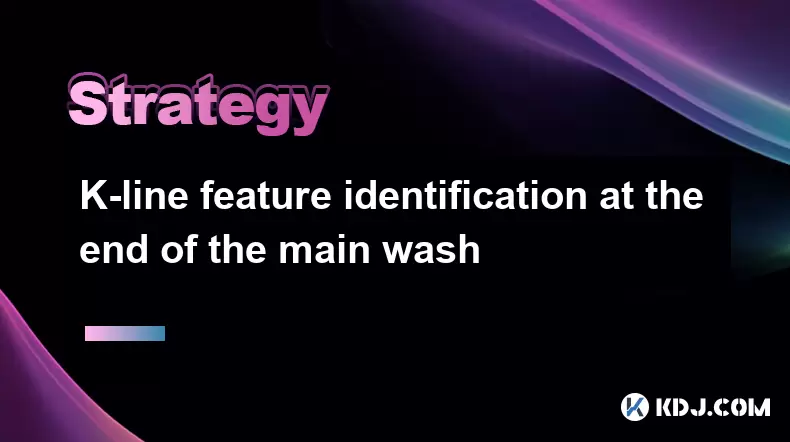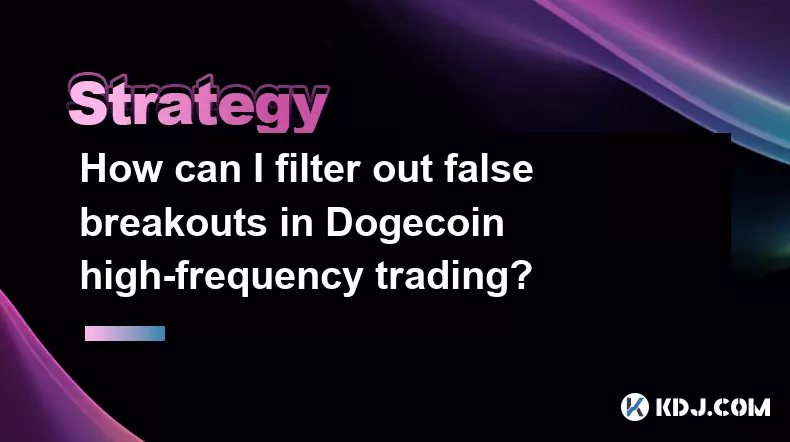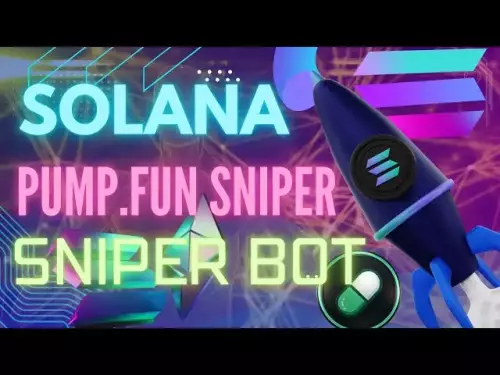-
 bitcoin
bitcoin $112195.049338 USD
2.42% -
 ethereum
ethereum $4124.915858 USD
2.81% -
 tether
tether $1.000570 USD
0.02% -
 xrp
xrp $2.861568 USD
2.25% -
 bnb
bnb $1000.346670 USD
3.04% -
 solana
solana $209.070819 USD
3.38% -
 usd-coin
usd-coin $0.999870 USD
0.02% -
 dogecoin
dogecoin $0.235379 USD
2.65% -
 tron
tron $0.335681 USD
-0.20% -
 cardano
cardano $0.803501 USD
3.38% -
 hyperliquid
hyperliquid $47.120881 USD
3.56% -
 chainlink
chainlink $21.501300 USD
3.44% -
 ethena-usde
ethena-usde $1.000571 USD
0.02% -
 avalanche
avalanche $29.793378 USD
3.62% -
 stellar
stellar $0.366964 USD
2.42%
K-line feature identification at the end of the main wash
At the end of the main wash, key K-line features like hammers, dojis, and engulfing patterns can signal potential market reversals, aiding informed trading decisions.
Jun 09, 2025 at 03:56 pm

Understanding K-line Features at the End of the Main Wash
In the world of cryptocurrency trading, understanding the K-line features at the end of the main wash can be crucial for making informed trading decisions. The main wash refers to a significant period of market correction or consolidation where prices undergo a major adjustment. Identifying specific K-line patterns at this stage can help traders anticipate potential reversals or continuations in market trends. This article will delve into the various K-line features that traders should look out for at the end of the main wash, providing detailed insights into each pattern and its implications.
Hammer and Inverted Hammer Patterns
At the end of the main wash, one of the most commonly observed K-line patterns is the hammer. A hammer is a bullish reversal pattern that forms at the bottom of a downtrend. It is characterized by a small body at the top of the candle and a long lower wick, indicating that sellers pushed the price down significantly during the session, but buyers managed to push it back up to near the opening price. The inverted hammer, on the other hand, is similar but appears at the top of an uptrend, signaling a potential bearish reversal.
To identify these patterns:
- Look for a candle with a small body at one end and a long wick at the other.
- Ensure the wick is at least twice the length of the body.
- Confirm the pattern with subsequent candles; a bullish confirmation for a hammer and a bearish confirmation for an inverted hammer.
Doji and Dragonfly Doji
Another critical K-line feature to observe at the end of the main wash is the Doji. A Doji is a candle where the opening and closing prices are virtually the same, resulting in a very small body. This pattern indicates indecision in the market and can signal a potential reversal. The Dragonfly Doji is a special type of Doji that has a long lower wick, resembling a hammer but with an even smaller body. It is a strong bullish reversal signal when it appears at the end of a downtrend.
To spot these patterns:
- Look for candles with very small bodies, where the opening and closing prices are nearly identical.
- For a Dragonfly Doji, ensure there is a long lower wick and no upper wick.
- Confirm the pattern with subsequent candles; a bullish confirmation is needed for both Doji and Dragonfly Doji.
Engulfing Patterns
Engulfing patterns are powerful reversal indicators that can be observed at the end of the main wash. A bullish engulfing pattern occurs when a small bearish candle is followed by a larger bullish candle that completely engulfs the previous candle's body. Conversely, a bearish engulfing pattern is formed when a small bullish candle is followed by a larger bearish candle that engulfs the previous candle's body. These patterns signify a shift in market sentiment and can signal the end of the main wash.
To identify engulfing patterns:
- Look for a small candle followed by a larger candle of the opposite color.
- Ensure the body of the second candle completely engulfs the body of the first candle.
- Confirm the pattern with subsequent price action; a bullish confirmation for bullish engulfing and a bearish confirmation for bearish engulfing.
Piercing Line and Dark Cloud Cover
The piercing line and dark cloud cover are two more K-line features that traders should watch for at the end of the main wash. A piercing line is a bullish reversal pattern that forms after a downtrend, consisting of a long bearish candle followed by a long bullish candle that opens below the previous close but closes above the midpoint of the previous candle's body. Conversely, the dark cloud cover is a bearish reversal pattern that forms after an uptrend, consisting of a long bullish candle followed by a long bearish candle that opens above the previous close but closes below the midpoint of the previous candle's body.
To identify these patterns:
- Look for a long candle followed by another long candle of the opposite color.
- For a piercing line, ensure the second candle opens below the previous close and closes above the midpoint of the first candle's body.
- For a dark cloud cover, ensure the second candle opens above the previous close and closes below the midpoint of the first candle's body.
- Confirm the pattern with subsequent price action; a bullish confirmation for a piercing line and a bearish confirmation for a dark cloud cover.
Morning Star and Evening Star
The morning star and evening star are three-candle reversal patterns that can be observed at the end of the main wash. A morning star is a bullish reversal pattern that forms at the bottom of a downtrend, consisting of a long bearish candle, followed by a small candle (which can be bullish or bearish) that gaps down, and then a long bullish candle that closes well into the body of the first candle. An evening star is a bearish reversal pattern that forms at the top of an uptrend, consisting of a long bullish candle, followed by a small candle that gaps up, and then a long bearish candle that closes well into the body of the first candle.
To identify these patterns:
- Look for a long candle followed by a small candle and then another long candle of the opposite color.
- For a morning star, ensure the second candle gaps down and the third candle closes well into the body of the first candle.
- For an evening star, ensure the second candle gaps up and the third candle closes well into the body of the first candle.
- Confirm the pattern with subsequent price action; a bullish confirmation for a morning star and a bearish confirmation for an evening star.
Frequently Asked Questions
Q: How can I differentiate between a hammer and a hanging man?A: Both the hammer and the hanging man have similar structures with a small body and a long lower wick. The key difference lies in their positions within the trend. A hammer appears at the bottom of a downtrend, signaling a potential bullish reversal, while a hanging man appears at the top of an uptrend, signaling a potential bearish reversal.
Q: Is it necessary to wait for confirmation after identifying a K-line pattern?A: Yes, it is highly recommended to wait for confirmation before making trading decisions based on K-line patterns. Confirmation can come in the form of subsequent candles that move in the direction indicated by the pattern or additional technical indicators that support the reversal signal.
Q: Can K-line patterns be used as standalone signals for trading?A: While K-line patterns can provide valuable insights into potential market reversals, they are most effective when used in conjunction with other technical analysis tools, such as trend lines, support and resistance levels, and other indicators. Relying solely on K-line patterns can lead to false signals and increased risk.
Q: How frequently do these K-line patterns occur at the end of the main wash?A: The frequency of these K-line patterns can vary depending on market conditions and the specific cryptocurrency being traded. However, they are commonly observed at the end of significant market corrections or consolidations, making them important signals for traders to watch for during these periods.
Disclaimer:info@kdj.com
The information provided is not trading advice. kdj.com does not assume any responsibility for any investments made based on the information provided in this article. Cryptocurrencies are highly volatile and it is highly recommended that you invest with caution after thorough research!
If you believe that the content used on this website infringes your copyright, please contact us immediately (info@kdj.com) and we will delete it promptly.
- News, September 28th, Headlines: Crypto's Wild Ride
- 2025-09-29 20:45:13
- Altcoins, Investors, and Potential Gains: Riding the 2025 Crypto Wave
- 2025-09-29 20:45:13
- Citi Token Services: Revolutionizing Cross-Border Payments and Liquidity Management
- 2025-09-29 20:50:01
- JYAI Token Gears Up for Launch: LCX Exchange Listing Imminent
- 2025-09-29 20:50:01
- Prenetics, Bitcoin Holdings, and Corporate Bitcoin: A New Era?
- 2025-09-29 20:25:11
- Swift, Altcoins, and Shifting Sands: Diving into Crypto's Latest Details
- 2025-09-29 20:25:11
Related knowledge

Practical parameter settings for a Bitcoin multi-timeframe moving average system
Sep 18,2025 at 10:54pm
Optimizing Timeframe Combinations for Bitcoin Trading1. Selecting appropriate timeframes is crucial when building a multi-timeframe moving average sys...

How can I filter out false breakouts in Dogecoin high-frequency trading?
Sep 22,2025 at 01:00am
Understanding False Breakouts in Dogecoin Trading1. A false breakout occurs when Dogecoin's price appears to move beyond a defined support or resistan...

Techniques for identifying tops and bottoms in the Bitcoin on-chain NVT model
Sep 20,2025 at 07:54pm
Understanding the NVT Model in Bitcoin Analysis1. The Network Value to Transactions (NVT) ratio is often described as the 'P/E ratio' of the cryptocur...

What does the surge in open interest in Bitcoincoin futures mean?
Sep 20,2025 at 11:18pm
Understanding the Surge in Dogecoin Futures Open Interest1. A surge in open interest within Dogecoin futures indicates a growing number of active cont...

How can I use the Ethereum USDT premium to gauge market sentiment?
Sep 18,2025 at 11:55pm
Understanding the Ethereum USDT Premium1. The Ethereum USDT premium refers to the price difference between USDT (Tether) traded on Ethereum-based plat...

What should I do if Ethereum staking yields decline?
Sep 20,2025 at 06:18am
Understanding the Causes Behind Declining Ethereum Staking Yields1. The Ethereum network transitioned to a proof-of-stake consensus mechanism with the...

Practical parameter settings for a Bitcoin multi-timeframe moving average system
Sep 18,2025 at 10:54pm
Optimizing Timeframe Combinations for Bitcoin Trading1. Selecting appropriate timeframes is crucial when building a multi-timeframe moving average sys...

How can I filter out false breakouts in Dogecoin high-frequency trading?
Sep 22,2025 at 01:00am
Understanding False Breakouts in Dogecoin Trading1. A false breakout occurs when Dogecoin's price appears to move beyond a defined support or resistan...

Techniques for identifying tops and bottoms in the Bitcoin on-chain NVT model
Sep 20,2025 at 07:54pm
Understanding the NVT Model in Bitcoin Analysis1. The Network Value to Transactions (NVT) ratio is often described as the 'P/E ratio' of the cryptocur...

What does the surge in open interest in Bitcoincoin futures mean?
Sep 20,2025 at 11:18pm
Understanding the Surge in Dogecoin Futures Open Interest1. A surge in open interest within Dogecoin futures indicates a growing number of active cont...

How can I use the Ethereum USDT premium to gauge market sentiment?
Sep 18,2025 at 11:55pm
Understanding the Ethereum USDT Premium1. The Ethereum USDT premium refers to the price difference between USDT (Tether) traded on Ethereum-based plat...

What should I do if Ethereum staking yields decline?
Sep 20,2025 at 06:18am
Understanding the Causes Behind Declining Ethereum Staking Yields1. The Ethereum network transitioned to a proof-of-stake consensus mechanism with the...
See all articles


























![[Pycoin] PI Coin -Shocking Listance of Pycoin?! 'Rebellion' This time ... Pay attention to #paikoin [Pycoin] PI Coin -Shocking Listance of Pycoin?! 'Rebellion' This time ... Pay attention to #paikoin](/uploads/2025/09/29/cryptocurrencies-news/videos/pycoin-pi-coin-shocking-listance-pycoin-rebellion-time-pay-attention-paikoin/68da82f23cec1_image_500_375.webp)















































